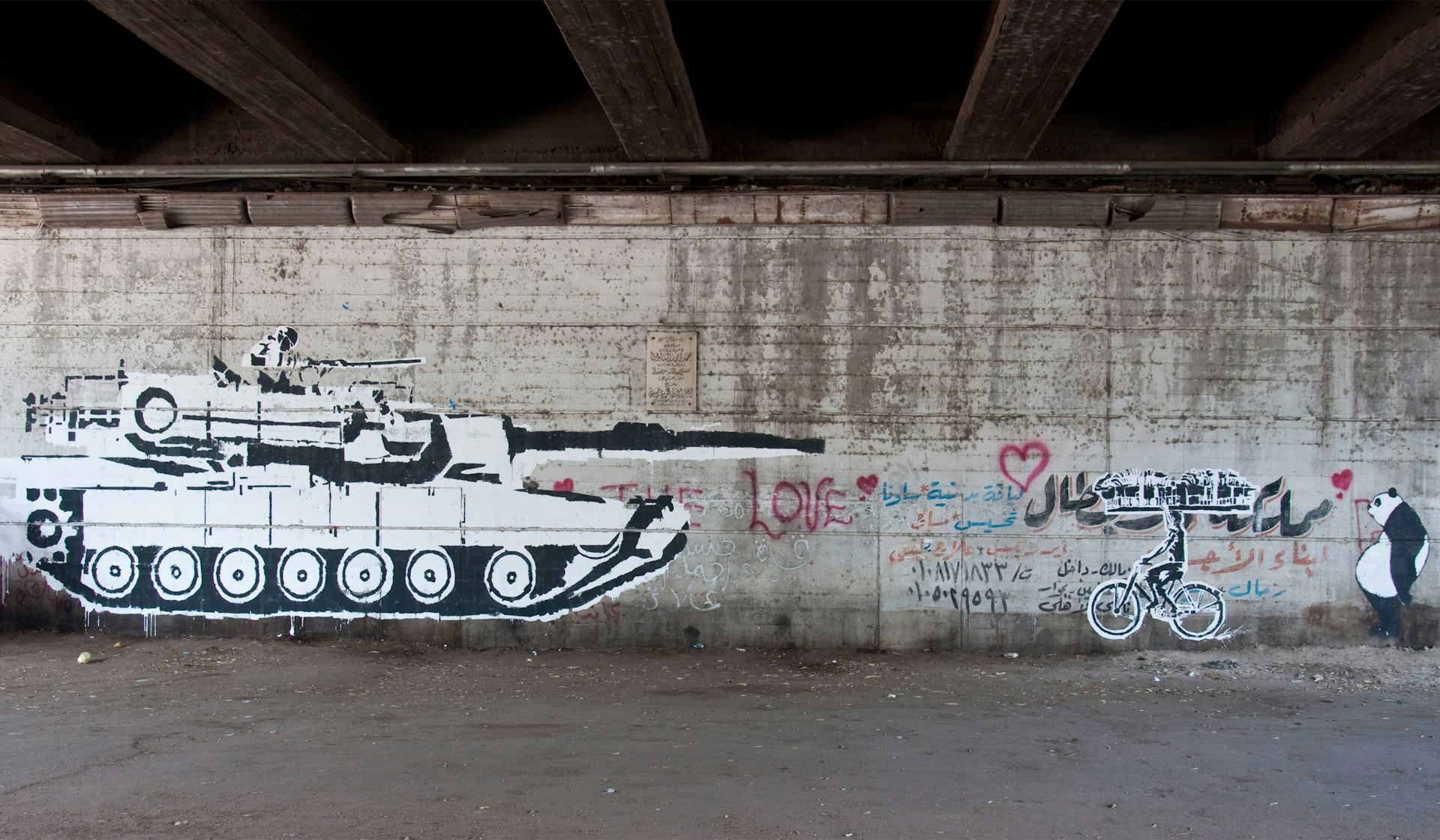
Egypt Now
- Text by Alex King
- Photography by Art by Ganzeer, Photo by Jo Anna Pollonais
As people all over the world tried to interpret the motivations and demands of the crowd that occupied Tahrir Square in 2011, the flowering of politically engaged graffiti came as a tangible statement of intent. And that statement was everywhere. At a time when nobody could trust the official media narrative of events, the walls became spaces where ideas and debates within the revolution played themselves out in a cacophony of colours and voices.
All Egyptians who wrote, stencilled on walls, defaced propaganda posters or wrote on army tanks with permanent markers played a role in the revolution by making their voices heard, but Ganzeer was one of several artists who rose to prominence and became recognised internationally.
Although he rejects the activist label, Ganzeer played a huge role in encouraging the use of street art as a revolutionary tool. In January 2012, when it appeared that the military council who governed Egypt after Mubarak’s downfall was resisting protestors’ demands, Ganzeer launched Mad Graffiti Week with this declaration: “Our only hope right now is to destroy the military council using the weapon of art. From January 13 to 25, the streets of Egypt will see an explosion of anti-military street art. If you are a street artist elsewhere in the world, please do what you can in your city to help us.” His call was answered in spectacular fashion, but the ensuing graffiti mobilisation was just one of many efforts that eventually helped to achieve official elections later in the year.
How much of a role do you feel street art played in the Egyptian revolution?
Well to answer your question, I’ll give you an example. It’s January 25, 2011. I arrive in Tahrir Square at the exact moment a huge march, the biggest I had seen in my life up to that point, clashes with a deployment of riot police. The security forces are overwhelmed and retreat to the fringes of the square, which has now been taken over by the protest movement. Powerful chants erupt ‘Bread! Freedom! Social Justice!’ and ‘Down, down with Hosni Mubarak!’ There is a billboard in the centre of the square sporting a National Democratic Party advertisement, Mubarak’s ruling party. I climb the billboard and spray the words that people are chanting ‘Down with Hosni Mubarak!’ The crowd in the square erupts with cheers and whistles. So… did street art play a role? I leave the conclusion up to you.
Would you describe yourself as an artist or an activist?
Artist, for sure. I see a problem with people being labelled ‘activist,’ like it’s a job. Caring about society or the world is not a job description. It’s okay to be a doctor, or an engineer, or an artist /and/ care about the world. If a musician only sings about love and relationships, he isn’t labeled some sort of ‘professional romantic.’ But if a musician sings about social issues, all of a sudden everybody rushes to slap an ‘activist’ label on him or her. I am an artist: I use my art to express my views in regards to a myriad of issues, and sometimes these will be social or political or whatever.
What has happened to freedom of expression in Egypt since the Sisi coup?
It has been seriously repressed. I don’t think I’ve ever witnessed such an active repression before. It’s very reminiscent of what the old folks would tell us about the days under Gamal Abdel Nasser in the 50s and 60s. This dangerous kind of repression is heralded by the masses for the sake of some kind of propagated security in the face of a propagated terror.
Does street art still have a political role to play in post-coup Egypt?
Absolutely! Although strategies must change a little. It’s vital to spread the energy out from the capital. The authorities will crack down hard on any direct opposition to Field-Marshal Sisi, so it’s important to be even more creative and target concepts rather than objecting to the person. Perhaps its best to criticise the very notion of a military-controlled government in clever ways. By doing so, the message will pass through the censors and have an impact that lasts beyond Sisi.
I get the sense that the Sisi coup is far from the end of this story, or for the complex revolutionary process. What is the next chapter for Egypt?
Buddy, the revolution is faaaaaaaaaaaaaar from over. Ever since it took off in 2011, we’ve been going through a series of ups and downs. Right now, at this particular moment you ask me this question, we’re experiencing one hell of a major down. But in my view, this is a small part in a very long post-colonial transition period. Ever since the overthrow of the British puppet King Farouk in 1952, there’s been a power-struggle to rule Egypt. Power has always been in the hand of inept military men – except during the short-lived rule of the Muslim Brotherhood, when power was shared with inept conservative bigots. But the struggle against the military will continue, because it is their grip over the nation that frustrates the goals of the people: ‘Bread! Freedom! Social Justice!’ The revolution will continue until those three things are achieved.
Ganzeer’s work is featured in Walls of Freedom, a collaborative book project on Egyptian revolutionary street art, out now.
To read more from Egypt Now: youth, music, street art and revolution in today’s Egypt, pick up a copy of Huck 43 – Street Photography With Boogie.
